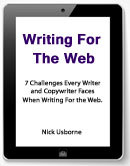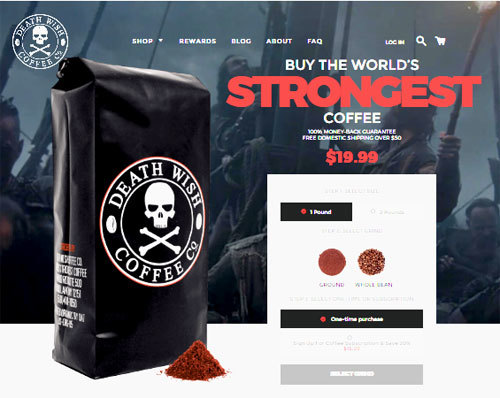Nick Usborne's Blog, page 16
October 10, 2016
Please help me with my new course on writing headlines.

Way back in July I was trying to figure out the topic for my next short course.
So far I’ve published two short-form courses this year – on content optimization and on selling with stories.
I wasn’t sure what to tackle next.
So I asked everyone who reads my newsletter to take part in a short survey.
I made two suggestions for my next course:
– The Craft of Conversational Copywriting
– Headline Writing for Online Writers and Copywriters
My guess was that most people would choose the second option. But I was wrong. About 60% of the people who took the poll chose the first option.
Hmmm… well, the whole point of asking people questions is to listen to what they say. Give your readers what they want!
So I started work on outlining a course on Conversational Copywriting.
And struggled, and stumbled, and ground to a halt.
Then I tried a couple of other topics. With the same outcome.
Finally, I circled back to the topic of headline writing.
And that course has been flowing out of me like honey on a warm summer’s day. : )
There’s a lesson here.
Yes, ask questions and listen to what people want from you. That’s marketing 101.
But… if you force it, if you try to create something that doesn’t come naturally, you’re going to struggle. At best you’ll create something that is forced, and certainly not your finest work.
You can apply this lesson to many different areas of your professional life… whether it’s choosing a niche for your freelance business, or deciding on which clients to approach next.
Yes, listen to the market. But also, listen to yourself.
All that brings me to the real reason I’m writing this…
I’m almost done putting together the slides for the course on headline writing. Next up is to start recording the lectures.
But… before I get to the recording stage, I want to reach out once again and ask you this:
If you were to buy a course on writing headlines, what three things would you really, really like to learn?
Do you have any burning questions on your mind when it comes to writing headlines for online content?
(This course is not about writing headlines for sales letters or sales pages. It’s about writing headlines for content pages, blog posts, home pages… and even for ‘kind of headlines’ like email subject lines and tweets.)
Got questions or requests?
If you have any questions you’d like answered in my new course, or requests about what you’d like to see covered, please let me know.
Send me your thoughts via the form on my Contact page.
In return, I’ll make sure you are among the first to hear when the course goes live. And you’ll get a special contributor’s discount as well!
Thank you in advance!

If you found this post helpful, sign up for my e-newsletter and get a free copy of my 35-page guide…
Writing For The Web #1 — 7 Challenges every Writer and Copywriter faces when writing for the Web.
Sign up and I’ll send you the link for the download, and then you’ll receive my most recent post as part of my e-newsletter every Tuesday morning.
Sign Up for my Excess Voice Newsletter…
Name:
Email:
0 subscribers
We respect your privacy
Email Marketing by GetResponse
(Your email address will be used only for the purpose of sending you this newsletter, and you’ll be free to unsubscribe at any time.)
The post Please help me with my new course on writing headlines. appeared first on Writing for the web - online copywriting and content writing..
October 2, 2016
7 Blog post ideas for any small business.

Most days in the summer months I go cycling for an hour or so after work.
And every few months I find myself at my local cycling store. Maybe for a new inner tube, some better gloves, or just to salivate over their high-end road bikes.
Over the years I have come to know the owner a little bit. And he knows I do marketing work.
Anyway, the last time I was there he was telling me that a business friend of his had suggested he create a blog for his store, and write a new post for it every week.
“But what would I say?” he asked me.
That made me smile, because I hear the same question from so many small business owners.
In their minds they see themselves writing a single page about their business and what they do… and then think they are done, and there is nothing more to say. Ever.
Maybe this is just a hangover from the days of writing product or business brochures. You wrote what you wanted to say, had it printed with some nice pictures as a brochure. And that was that.
Anyway, with my cycling store owner, I began to rattle off a list of ways in which he could create a new post a week, indefinitely.
Blog post idea #1: Interview a customer
A lot of business owners think marketing communications is all about pitching their own business and sharing company news, all the time. Not so.
Sometimes you should stop talking about your business and start listening to and sharing the experiences of your customers.
My cycle store owner could interview one of his customers each month. I bet if he started asking some of the customers he sees regularly he could find some great stories to share. Good photo opportunities too.
Blog post idea #2: Review your latest bike
The guy has a bike shop. He has new bikes and accessories coming in all the time.
Why not review the best and coolest stuff? People love reviews, and find a lot of value in them when they are created by true experts.
Blog post idea #3: Cover a local cycling event
As with the reviews, his expertise and reputation put him in a strong position to report on local cycling events and races. It’s a great way for him to get exposure in local media as well.
This is a local business. Unless he starts selling stuff online – which I‘m guessing he won’t – his target market is people within a radius of maybe 10 miles or so.
But within that 10-mile radius he has competitors. By becoming the go-to expert for covering local events, he can further separate himself from his competitors.
Blog post idea #4: Interview an expert
This guy is about my age and has been in the business for decades. I bet he knows people in the industry he could interview. He probably knows people at most of the major cycle manufacturers.
If I pushed him a little – we all have to push our clients a little, from time to time – I bet we could come up with a list of industry experts he could interview for his blog.
Blog post idea #5: How to adjust your gears
Type the words “how to” into Google or YouTube and you’ll get a zillion results.
When people want to know how to do something, they turn to the web.
So my guy can create dozens of how-to posts, tutorials and videos about bikes.
How to adjust your gears. How to choose the right cycling shoes. How to choose your next bike. And so on.
Heck, he could write two or three posts a week forever… just with this one approach.
Blog post idea #6: Monthly Q&A
Involve your readers and customers… always! So my guy can invite his customers to submit their cycling-related questions and he can do a weekly or monthly roundup of questions and answers.
He can do this as a regular text-based blog post.
He can do it as a vlog.
He can do it on Facebook or Twitter.
This is an old-school store owner, so I think I would get him started with the blog posts. But for your own clients, remember that their own website or blog isn’t always the best option. Some things are better done on Facebook, YouTube, Instagram or some other platform.
Blog post idea #7: Monthly photo roundup
He can take photos, as can his staff. Better still, he can ask his customers to submit their photos.
Why would his customers send in photos? For the fun of it. To be part of something. But if you’re worried about people participating, turn it into a monthly contest. Give something away as a prize for the best photo.
We can keep this guy’s blog going for years…
I have lost count of the number of times a small business owner has told me they can’t have a blog because they wouldn’t have anything to say.
That’s nonsense.
There is nothing unique about a cycle store.
These 7 blog posts ideas just scratch the surface, and most of them can be applied to pretty much any business.
So next time a client gets nervous about launching or relaunching a blog, you can tell them not to worry about it.
You’ll take care of everything.
And now you’ve landing yourself a recurring gig, with monthly billing.
Sound good?
NOTE: For more on web content creation and optimization – check out my course, Web Content Optimization.

If you found this post helpful, sign up for my e-newsletter and get a free copy of my 35-page guide…
Writing For The Web #1 — 7 Challenges every Writer and Copywriter faces when writing for the Web.
Sign up and I’ll send you the link for the download, and then you’ll receive my most recent post as part of my e-newsletter every Tuesday morning.
Sign Up for my Excess Voice Newsletter…
Name:
Email:
0 subscribers
We respect your privacy
Email Marketing by GetResponse
(Your email address will be used only for the purpose of sending you this newsletter, and you’ll be free to unsubscribe at any time.)
The post 7 Blog post ideas for any small business. appeared first on Writing for the web - online copywriting and content writing..
September 26, 2016
But Nick, you didn’t teach me how to create stories that sell. Fail!
 I have paraphrased a little, but that’s pretty much what someone wrote after taking my course, Selling with Stories.
I have paraphrased a little, but that’s pretty much what someone wrote after taking my course, Selling with Stories.
He felt a little disappointed because I hadn’t given him a structure or template he could use for creating stories as part of his direct sales promotions. My bad. Kind of.
My mistake, I think, was not in what I taught… but in how I failed to be 100 percent clear about what I’d be teaching.
When I created the course I did so based on a strong belief that the whole idea of “selling” online is changing, and changing fast.
The traditional hard-sell approach is on the way out.
A more sincere and story-based style of selling is on the way in.
There are two reasons for this.
First, the social web just isn’t a natural venue for the hard sell.
In fact, any social setting is a bad place for a direct sales pitch. Maybe you’ve been to a neighborhood BBQ and had someone approach you with his or her latest multi-level marketing pitch. Wrong place. Wrong time. Totally unwelcome.
If you want to be all about the pitch, there are places you can do that.
TV ads, print magazine ads, billboards and direct mail are all one-way communications platforms. The advertiser talks at an audience. Not social at all. So if you want to go for the hard sell in those places, knock yourself out.
But when you’re in a social setting, the rules are different.
Now consider “story” and how that fits into a social setting.
If someone comes up to you at that BBQ and starts telling you an interesting story, that’s OK. Could be a funny story, a sad story, an entertaining story or a story with some timely news included.
Stories told and shared at BBQs, around the water cooler at work, in your favorite bar, or around the kitchen tale at home… they are all welcome.
The hard sell is not a good fit within social settings.
Telling stories is the perfect fit within social settings.
Knock-knock… the web is a social setting!
The web is not one of those old-school, one-way communications platforms where companies can shout at their audience.
The web is a shared, social platform and always has been. But with the growth of social media, the social nature of the web is becoming increasingly clear.
And that means if you want to sell products or services online, you have to “abide by the new rules”.
You have to sell in a way that is acceptable in a place where communications are, for the most part, social.
Which brings me to the second reason why the long-form, hard-hitting sales approach is a poor fit online…
The web is moving to mobile.
Take a look at anyone younger than 40 and you’ll see they spend very little time on their computers.
Most of their time online is spent on their smartphones.
And while they are on their phones, they spend most of the time on mobile apps, and not on the traditional web.
How well do you think your “selling at them” approach is going to work with an audience that spends most of its time on fast-moving, social platforms like Facebook, Instagram and Snapchat?
If you want to sell to a socially engaged audience, you need a socially engaging vehicle – like stories.
OK… so why did my customer think my course was a fail?
Because he thought I would teach him how to fit stories into a traditional sales structure.
He thought he would learn how use stories to make his traditional sales pitches stronger.
But that’s not what I teach in Selling with Stories.
What I teach is how a good story can replace the traditional sales approach. I show you how a good story can hook an audience of prospects, appeal to their hearts as well as their heads, engage them more deeply, and make them want to become your customers.
More pulling and less pushing.
On the social web, stories are replacing sales copy as the smart way to build an audience of engaged prospects… and to then convert those prospects into happy customers.
NOTE: If you want to know more about the power of telling stories, check out my course, Selling With Stories…

If you found this post helpful, sign up for my e-newsletter and get a free copy of my 35-page guide…
Writing For The Web #1 — 7 Challenges every Writer and Copywriter faces when writing for the Web.
Sign up and I’ll send you the link for the download, and then you’ll receive my most recent post as part of my e-newsletter every Tuesday morning.
Sign Up for my Excess Voice Newsletter…
Name:
Email:
0 subscribers
We respect your privacy
Email Marketing by GetResponse
(Your email address will be used only for the purpose of sending you this newsletter, and you’ll be free to unsubscribe at any time.)
The post But Nick, you didn’t teach me how to create stories that sell. Fail! appeared first on Writing for the web - online copywriting and content writing..
September 13, 2016
How to differentiate your product with a compelling story.
 As you may know, I have a bit of a thing for coffee.
As you may know, I have a bit of a thing for coffee.
I have way too much coffee making equipment, and have tried dozens of different coffees from all over the world.
And… given what I do for a living… I have become something of a student of the coffee business.
When it comes to marketing, coffee presents us with a few challenges.
First off, coffee is essentially a commodity. Literally, it is second only to oil in terms of its value as a traded commodity.
But from a marketer’s and a copywriter’s point of view, coffee is a commodity because… well… it’s just a green bean that is roasted until it’s brown.
It’s a brown bean.
Whether you’re Starbucks or a just-started coffee roaster, you’re playing the same game and selling the same thing… that small brown bean.
Fortunately, coffees from different parts of the world have slightly different tastes. So there are some flavor differences we can work with.
And the roaster can roast light, medium or dark, which gives us a few other points of difference when we try to sell a particular coffee.
But origin and roast can only take you so far when it comes to marketing and differentiating a coffee.
This is particularly true when you look at the number of coffee companies, roasters and coffee stores out there, all telling variations of this one story.
So… going back a decade or two… coffee companies began to look for other stories to tell. And the story a lot of companies chose to tell was about the people who grew and picked the coffee beans.
We saw a lot of photos and videos of coffee company founders visiting the places where their coffees were grown. Boots on the ground, and all that.
That was great… until everyone began to tell the same story.
And that’s how it seems to go with the coffee business. As soon as someone latches onto a new storyline, everyone jumps in and does the same.
You can’t blame them, because they’re all trying to sell the same, small brown bean.
Here’s the trick…
Differentiate your business with a story that’s hard to copy.
Occasionally a company breaks through with something different.
Like the folks at Death Wish Coffee.
They have a new story baked into the business name itself.
They’re telling the story of a coffee that is stronger than any other.
They position themselves as “The world’s strongest coffee”.
Wanna try our coffee? Better have a death wish first.
Recently they won the grand prize in a competition put together by Intuit to encourage small business.
Their winning video shows a bunch of crazy Viking warriors in a boat, fueling their bloodlust with Death Wish Coffee.
They follow the same narrative everywhere, across the brand experience. Their packaging is black, their logo shows a skull and crossbones.
It’s death wish all the way.
And it’s marketing all the way too because… well… they never really do explain how and why their coffee is the strongest in the world.
What does that even mean? The highest caffeine content? The darkest roast? The boldest taste?
They don’t even define it or attempt to prove it.
The closest they come is to make a soft claim about their “unique roasting process”. Well, if you know much about roasting coffee, you’ll know to take that claim with a pinch of salt.
But to get caught up with whether or not they can justify their claim is to miss the point.
What they are doing… and they’re doing it really well… is to differentiate their coffee with a powerful story.
And it’s a story that isn’t easy to copy.
Best of all, they have a storyline they can dip into in a multitude of ways for years to come. They now own the Death Wish story.
This is the differentiating power of a good story.
Like I said at the outset, coffee is a commodity. And that makes it a great model for marketers trying to figure out how to differentiate their own products or services.
If something can work for coffee, it can probably work for anything.
And in my experience in watching coffee marketing closely for over 10 years now, the best way to differentiate any product or service is with a powerful story.
So next time you’re faced with trying to create a new campaign or promotion for what is essentially a “me too” product or service, just ask yourself the question…
What’s the most powerful story we can tell?
NOTE: If you want to know more about the power of telling stories, check out my course, Selling With Stories…

If you found this post helpful, sign up for my e-newsletter and get a free copy of my 35-page guide…
Writing For The Web #1 — 7 Challenges every Writer and Copywriter faces when writing for the Web.
Sign up and I’ll send you the link for the download, and then you’ll receive my most recent post as part of my e-newsletter every Tuesday morning.
Sign Up for my Excess Voice Newsletter…
Name:
Email:
0 subscribers
We respect your privacy
Email Marketing by GetResponse
(Your email address will be used only for the purpose of sending you this newsletter, and you’ll be free to unsubscribe at any time.)
The post How to differentiate your product with a compelling story. appeared first on Writing for the web - online copywriting and content writing..
September 7, 2016
When selling online, content does most of the heavy lifting.

Ask an online copywriter how to sell stuff online, and she’ll likely tell you it’s all about great sales copy.
Makes sense, right?
If you want to sell stuff, you need strong copy that sells hard and closes the sale.
Well, this may have been the case back in the days before the web.
But today I would argue, and do argue, that most of the heavy lifting is actually done by web content, not sales copy.
Why? In large part because consumers online are becoming increasingly resistant to sales messages. In particular, they dislike sales messages that interrupt them and get in the way of what they really want to do.
In my own case, this is why I have a very twitchy trigger finger when it comes to deleting emails that interrupt me with their sales pitches.
Yes, even if I subscribed to those lists. Even if I gave those marketers “permission”. I’m quick to change my mind. Maybe I was OK with your sales pitch yesterday, but not today.
Is that unfair to the marketer? Maybe. But I don’t care, and nor does anyone else.
Like tens of millions of other people, I have also installed an ad-blocker on my browser. Why? Because when I tried to read articles online I would be deluged with ads, some of which overlaid the articles I was trying to read.
Unfair of me to install an ad-blocker? Maybe. Get over it.
And I’m an old guy! My generation is pretty patient with ads. My kids and their kids. Ha! They’re way faster at finding ways to get rid of all those ads and sales messages.
For a start, they barely use email. At all. And they have ad-blockers on their laptops, their tablets and their smartphones.
They don’t want to see your ads or read your sales copy. They won’t be fooled or impressed by your cunning headlines and your smooth transitions.
BUT… they will enjoy your content. Your great stories, photo essays and videos.
This is how great content does the heavy lifting when it comes to online sales.
Great content takes a stranger by the hand and slowly introduces her to your products or services.
Great content builds friendships, community and respect.
It builds trusts and breaks down barriers.
Great content leads your prospects to the point of sale, allowing you to close the sale with the very lightest of touches. Because by that point your prospect truly wants to buy… from you.
This is a trend that is building momentum, right now.
People are becoming less and less tolerant of traditional sales pitches and sales copywriting. This is particularly true of younger consumers, and anyone using mobile devices.
They don’t want another sales pitch.
But they always enjoy great content and a good story.
This is why I’ve been focusing so much on web content recently.
By profession and by training I’m a sales copywriter. But my focus these days is on content and story.
Over the last few months I have published a couple of short courses for online writers – whether you consider yourself an online copywriter or a content writer.
The first course is Web Content Optimization.
The second is Selling with Stories.
And right now I’m working on a third course, which drills down and looks at the nitty-gritty of what it takes to create a single page of great content.
As a copywriter I have become a content writer.
I sell with great content.

If you found this post helpful, sign up for my e-newsletter and get a free copy of my 35-page guide…
Writing For The Web #1 — 7 Challenges every Writer and Copywriter faces when writing for the Web.
Sign up and I’ll send you the link for the download, and then you’ll receive my most recent post as part of my e-newsletter every Tuesday morning.
Sign Up for my Excess Voice Newsletter…
Name:
Email:
0 subscribers
We respect your privacy
Email Marketing by GetResponse
(Your email address will be used only for the purpose of sending you this newsletter, and you’ll be free to unsubscribe at any time.)
The post When selling online, content does most of the heavy lifting. appeared first on Writing for the web - online copywriting and content writing..
August 30, 2016
You can sell with stories. Unless you use fake stories.
 A couple of weeks ago I got an email from a copywriter who wanted my take on a piece of story-based copy he had written.
A couple of weeks ago I got an email from a copywriter who wanted my take on a piece of story-based copy he had written.
It was a sales email, and it opened with a story.
Technically, the email was pretty well written.
It opened with the story, transitioned into sharing information about one of his client’s services, and then pivoted to a call to action at the end.
Quite nicely put together.
Just one problem.
The story he opened with didn’t feel right. It just felt false. Creepy. Kind of manipulative.
So I asked him about it, thinking maybe he was fed it by his client’s PR department.
Nope. Not even. He just made it up.
He thought that’s what he was meant to do. In fact, that was what he was taught to do.
Hmmm. Don’t do that.
A good story can be your best friend. It can hook your readers’ attention in a heartbeat. Or a teardrop. It can open emotional connections with your audience in ways that regular “copywriting” can never achieve.
But only if your stories are real, and true.
Instead of making up stories that nobody is going to believe, put in the hard work. Talk with your client. Get permission to talk with their employees. Talk with their customer service people. Keep talking and keep asking until you find a real story.
Here’s a hint for you. 9 times out of 10 the best stories will come from the customer service people. And 8 times out of 10, the marketing folks won’t be listening to their own customer service people. Crazy, but all too often true.
So that becomes your task.
You become the story hunter. Even if you have to be a pain, and hassle people.
It will be worth it, because when you find a real story worth telling and sharing, you’ll have found something special and very powerful.
Now you can go back and rewrite that email, or sales page, or content page, or social media update.
Now you can talk about something that really happened, with honesty and passion and enthusiasm.
Do that and you’re tapping into the true power of stories.
NOTE: If you want to know more about the power of telling stories, check out my course, Selling With Stories…

If you found this post helpful, sign up for my e-newsletter and get a free copy of my 35-page guide…
Writing For The Web #1 — 7 Challenges every Writer and Copywriter faces when writing for the Web.
Sign up and I’ll send you the link for the download, and then you’ll receive my most recent post as part of my e-newsletter every Tuesday morning.
Sign Up for my Excess Voice Newsletter…
Name:
Email:
0 subscribers
We respect your privacy
Email Marketing by GetResponse
(Your email address will be used only for the purpose of sending you this newsletter, and you’ll be free to unsubscribe at any time.)
The post You can sell with stories. Unless you use fake stories. appeared first on Writing for the web - online copywriting and content writing..
August 25, 2016
To make more sales, stimulate the release of this drug.

You’re walking down a busy street and a homeless person approaches you.
Your emotions are conflicted. You’re in a hurry. You don’t need the delay. You know you’re about to be hustled.
And yet…
So you pause and listen to “the pitch”.
If the homeless person just asks for money, you’ll probably say no and not even make eye contact.
But if he or she begins to tell you a story… about being hungry, about their kids, about their sick dog, about their mom who has cancer… you’ll more than likely find yourself reaching for some money.
Yes, you know the story is probably 100% fiction. Yes, you’ve heard it all before.
But you still reach for your money.
How come?
It turns out you can blame a single chemical. It’s called oxytocin.
Oxytocin’s release in the brain is triggered by stories.
And once in your brain, oxytocin stimulates feelings of empathy and trust.
Yes, stories change your brain chemistry. They change how you think, how you feel and even how you act.
That’s why the homeless person tells you a story. That’s why a conman will always tell you a story. That’s why kids tell their teachers stories when they’re late with their homework.
They may not be familiar with the science of oxytocin, but they know from experience that a good story breaks down resistance, builds trust and creates empathy.
If you don’t believe me, check out Paul Zak’s book, The Moral Molecule: How Trust Works. You’ll get over 250 pages on this one topic.
However, unless you want to read the book, you don’t really need to.
Because you already know about the power of stories and how they make you feel.
Think of a few of your favorite movies. Think about how they can make you laugh or cry. Or feel angry or inspired.
Or how James Bond or Jason Bourne can make any guy feel superhuman… just for a little while.
Or think about how you feel when watching a 2-minute video on Facebook. Maybe it’s funny. Maybe it’s sad. Maybe it’s just silly, but mildly entertaining.
But one way or another, a good story will always make you feel something.
Interestingly, video is a lot more powerful in this regard than text.
Watch a two-minute video about how a dog reacts when its owner returns after 6 months away from home, and you may well end up wiping tears from your eyes.
Read two minutes of text on the exactly same topic and your reaction won’t be anywhere near as powerful.
So… I think we all know how powerful stories are, and how they can influence how we feel and even how we act.
And that’s why stories can be such a good friend to online writers and copywriters.
We can drive ourselves and our readers to distraction with rational, detailed sales pitches. But if we don’t change how those readers are feeling, we probably won’t make the sale.
Hey… every copywriter knows people buy with our hearts and not with their heads.
And the best way to change how someone feels in their hearts is with a good story.
Think about that the next time you are writing some copy.
Remember that establishing trust is central to making a sale. If you want someone to buy, first they need to trust the company they’re about to buy from.
And remember that a good story stimulates the release of oxytocin in the brain.
And that oxytocin increases levels of empathy and trust.
It feels like cheating somehow. Like we have chemistry on our side as a secret weapon.
But that’s how it works.
Tell a good story. Let oxytocin do its work. Then, with trust established, make your pitch.
NOTE: If you want to know more about the power of telling stories, check out my course, Selling With Stories…

If you found this post helpful, sign up for my e-newsletter and get a free copy of my 35-page guide…
Writing For The Web #1 — 7 Challenges every Writer and Copywriter faces when writing for the Web.
Sign up and I’ll send you the link for the download, and then you’ll receive my most recent post as part of my e-newsletter every Tuesday morning.
Sign Up for my Excess Voice Newsletter…
Name:
Email:
0 subscribers
We respect your privacy
Email Marketing by GetResponse
(Your email address will be used only for the purpose of sending you this newsletter, and you’ll be free to unsubscribe at any time.)
The post To make more sales, stimulate the release of this drug. appeared first on Writing for the web - online copywriting and content writing..
Stimulate the release of this drug to make more sales.

You’re walking down a busy street and a homeless person approaches you.
Your emotions are conflicted. You’re in a hurry. You don’t need the delay. You know you’re about to be hustled.
And yet…
So you pause and listen to “the pitch”.
If the homeless person just asks for money, you’ll probably say no and not even make eye contact.
But if he or she begins to tell you a story… about being hungry, about their kids, about their sick dog, about their mom who has cancer… you’ll more than likely find yourself reaching for some money.
Yes, you know the story is probably 100% fiction. Yes, you’ve heard it all before.
But you still reach for your money.
How come?
It turns out you can blame a single chemical. It’s called oxytocin.
Oxytocin’s release in the brain is triggered by stories.
And once in your brain, oxytocin stimulates feelings of empathy and trust.
Yes, stories change your brain chemistry. They change how you think, how you feel and even how you act.
That’s why the homeless person tells you a story. That’s why a conman will always tell you a story. That’s why kids tell their teachers stories when they’re late with their homework.
They may not be familiar with the science of oxytocin, but they know from experience that a good story breaks down resistance, builds trust and creates empathy.
If you don’t believe me, check out Paul Zak’s book, The Moral Molecule: How Trust Works. You’ll get over 250 pages on this one topic.
However, unless you want to read the book, you don’t really need to.
Because you already know about the power of stories and how they make you feel.
Think of a few of your favorite movies. Think about how they can make you laugh or cry. Or feel angry or inspired.
Or how James Bond or Jason Bourne can make any guy feel superhuman… just for a little while.
Or think about how you feel when watching a 2-minute video on Facebook. Maybe it’s funny. Maybe it’s sad. Maybe it’s just silly, but mildly entertaining.
But one way or another, a good story will always make you feel something.
Interestingly, video is a lot more powerful in this regard than text.
Watch a two-minute video about how a dog reacts when its owner returns after 6 months away from home, and you may well end up wiping tears from your eyes.
Read two minutes of text on the exactly same topic and your reaction won’t be anywhere near as powerful.
So… I think we all know how powerful stories are, and how they can influence how we feel and even how we act.
And that’s why stories can be such a good friend to online writers and copywriters.
We can drive ourselves and our readers to distraction with rational, detailed sales pitches. But if we don’t change how those readers are feeling, we probably won’t make the sale.
Hey… every copywriter knows people buy with our hearts and not with their heads.
And the best way to change how someone feels in their hearts is with a good story.
Think about that the next time you are writing some copy.
Remember that establishing trust is central to making a sale. If you want someone to buy, first they need to trust the company they’re about to buy from.
And remember that a good story stimulates the release of oxytocin in the brain.
And that oxytocin increases levels of empathy and trust.
It feels like cheating somehow. Like we have chemistry on our side as a secret weapon.
But that’s how it works.
Tell a good story. Let oxytocin do its work. Then, with trust established, make your pitch.
NOTE: If you want to know more about the power of telling stories, check out my course, Selling With Stories…

If you found this post helpful, sign up for my e-newsletter and get a free copy of my 35-page guide…
Writing For The Web #1 — 7 Challenges every Writer and Copywriter faces when writing for the Web.
Sign up and I’ll send you the link for the download, and then you’ll receive my most recent post as part of my e-newsletter every Tuesday morning.
Sign Up for my Excess Voice Newsletter…
Name:
Email:
0 subscribers
We respect your privacy
Email Marketing by GetResponse
(Your email address will be used only for the purpose of sending you this newsletter, and you’ll be free to unsubscribe at any time.)
The post Stimulate the release of this drug to make more sales. appeared first on Writing for the web - online copywriting and content writing..
August 22, 2016
A visit to your local market will teach you plenty about selling with stories.
Each week my wife and I go to Jean Talon Market here in Montreal. It is one of the city’s busiest markets, particularly over the summer months.
Last week I took my camera along, in search of how stall holders might be using stories to help market their produce.
It’s funny how the mind works. As soon as I looked around in search of “story”, suddenly I was surrounded by them.
You’ll get the full roundup in the video above.
But a couple of examples jumped out at me.
First was the story of the husband and wife who created a poster to thank their son. They were thanking him for his decision to stay on the farm and keep it in the family for another generation. They also recognized that it was their son’s idea to open the stall at the market.
In an environment with dozens of different vegetable stalls, this one stood out, simply because of the story they chose to share.
The second example was another family story. This was about three generations of the same family, all involved in their tea and spice store.
Well, maybe two generations. The little girl representing the third generation was only about one year old!
But the little girl was there in the store, with her mom, and her mom’s mom. Plus her dad and her grandpa.
Their story is one of traveling the world in search of the best teas and spices. It’s a story of family and adventure.
By the time we had stocked up on fruit, veggies and teas for the week, and returned to our car… I was overflowing with stories.
The visit to the market had reconfirmed what I have been teaching in my latest course, Selling With Stories.
In a nutshell, the telling of stories is one of the most powerful ways to market and promote pretty much any business.
It doesn’t matter whether you work for a multinational brand or stand behind a vegetable stall at the weekends – telling a compelling story instantly sets you apart form the competition.
Stories also engage an audience at an emotional level that makes them far more likely to buy, and to become loyal to your business.
Stories rule!
You can find out more about my course, Selling With Stories, here…

If you found this post helpful, sign up for my e-newsletter and get a free copy of my 35-page guide…
Writing For The Web #1 — 7 Challenges every Writer and Copywriter faces when writing for the Web.
Sign up and I’ll send you the link for the download, and then you’ll receive my most recent post as part of my e-newsletter every Tuesday morning.
Sign Up for my Excess Voice Newsletter…
Name:
Email:
0 subscribers
We respect your privacy
Email Marketing by GetResponse
(Your email address will be used only for the purpose of sending you this newsletter, and you’ll be free to unsubscribe at any time.)

The post A visit to your local market will teach you plenty about selling with stories. appeared first on Writing for the web - online copywriting and content writing..
August 14, 2016
To change how people feel, just tell them a story.
 Ed White, during America’s first space walk.
Ed White, during America’s first space walk.If you’ve been involved in marketing for more than ten minutes, you’ve probably figured out that people buy things based on their emotions.
People don’t line up on the sidewalk all night to buy the latest iPhone for any rational reason.
It’s not like their existing iPhone is about to stop working.
They line up for the new phone not because they need it, but because they want it.
Their purchase decision is driven by emotion.
And it turns out that one of the best and fastest ways to trigger emotions is through stories.
You know this already, of course.
Every time you watch a movie you’re taken on an emotional roller-coaster. Movies are stories, and stories move us.
Stories make us laugh and cry. They make us feel fear and anger. They can make us feel love. And feel inspired.
Movie do this to us, and so do good books.
Even a 3 minute 40 second YouTube video can move us. Profoundly.
Watch this one, from Dove.
The folks at Dove created a story. This is the story of how women feel about themselves when asked to choose between seeing themselves as either beautiful or average.
American Family Insurance moves us with a story of their own, in just 2 minutes and 30 seconds.
These stories change the way we feel about Dove and American Family Insurance.
Stories trigger emotions.
Sometimes those stories are made up – like the father and son story for the insurance company.
Sometimes the story comes from a scenario that is set up with the intent to create a story – as with the Dove video.
And sometimes the story is drawn from real life.
For example, if I offered you a choice between a Rolex watch and an Omega watch, which would you choose?
Both are luxury watches. And they both do a good job of telling the time.
Sure, Rolex may seem like they have the edge when it comes to luxury.
But let me tell you a story…
In 1965, during the Gemini 4 spaceflight, Ed White made the first American spacewalk with an Omega Speedmaster watch strapped to his left wrist.
Omega Speedmaster watches were also worn by Neil Armstrong and Buzz Aldrin during the Apollo 11 flight to the moon.
During the troubled Apollo 13 mission, the Omega Speedmaster was used to time a critical rocket burn when the spacecraft’s computer was down.
Rolex? Sure… if tennis and golf are your thing.
But I think I’ll go for the watch that proved itself in space, on the wrists of astronauts.
Luxury watches are defined by stories.
As are cars, running shoes and just about any other product or service.
So next time you’re scratching your head, wondering what angle to take when writing an ad, email or some other promotion, think about what kind of story you could tell or create.
Remember, stories stimulate emotions.
And emotions drive sales.
BTW – If you think you might be interested in my upcoming course – Selling with Stories – reach out to me through my Contact page and type “I love stories” in the message field. You’ll then hear about the course “pre-launch”, and you’ll get a special, extra discount on the price!

If you found this post helpful, sign up for my e-newsletter and get a free copy of my 35-page guide…
Writing For The Web #1 — 7 Challenges every Writer and Copywriter faces when writing for the Web.
Sign up and I’ll send you the link for the download, and then you’ll receive my most recent post as part of my e-newsletter every Tuesday morning.
Sign Up for my Excess Voice Newsletter…
Name:
Email:
0 subscribers
We respect your privacy
Email Marketing by GetResponse
(Your email address will be used only for the purpose of sending you this newsletter, and you’ll be free to unsubscribe at any time.)
The post To change how people feel, just tell them a story. appeared first on Writing for the web - online copywriting and content writing..
Nick Usborne's Blog
- Nick Usborne's profile
- 6 followers





